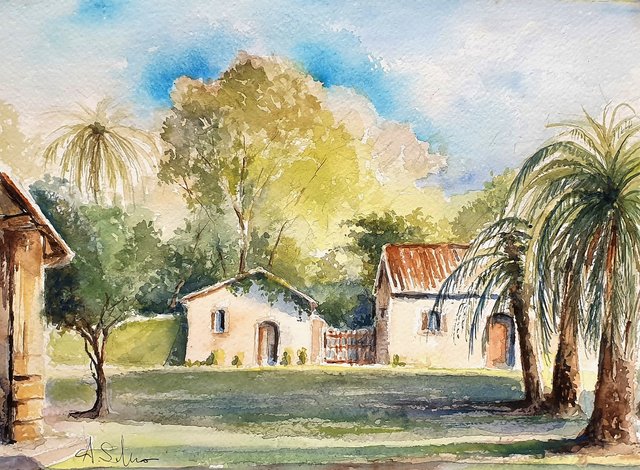

2 0 2 0
watercolor on paper

How to get good lights in watercolor painting.
Hello to all dear friends and welcome back to my blog. I hope you are well and safe and that you are having a peaceful quarantine. Today I share with you a series of paintings where I face the problem of shadows in watercolor painting.
As many of you know, the first problem we have in watercolor painting is that we work in the negative, that is, from light to dark.
Then light colors are applied first and then darker tones by overlapping.
While in oil or acrylic painting we can add whites to make the lights at the end of the painting, with the watercolor painting technique this is not possible.
There is no white watercolor!
In this video you can see how from the white of the sheet of paper I arrive to the dark tones (violet and blue) for overlapping of color glazes.
If then you want to make a tempera or gouche painting then white exists, but it is not a watercolor but it is simply a gouache or a tempera painting.
The light of a good watercolor is transmitted to us by the white color of the sheet of paper, and the more we color over the sheet the more the watercolor risks losing its brightness.
Beginners tend to fill the design with a lot of color, and by superimposing them on each other, they often risk having a painting that is not very bright and shiny, with dull colors and devoid of vitality.
So today I give you some suggestions with visual examples on some of my watercolors and how you can create shadows on the elements of the landscape or nature.

The first important and fundamental tip to get a good bright painting is to not color the shadows with black, the black color is rarely used!
Forget black!
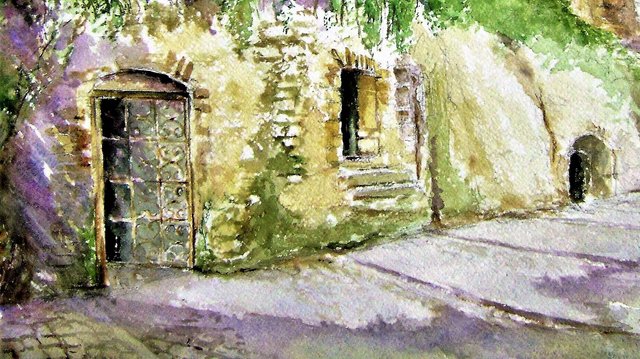
For example, if I have to create shadows on a landscape, it is better to use violet, and if you mix it with cobalt blue it is even darker but retains a good brightness.
If I want to get a very dark shade, I superimpose Payne's gray on violet.
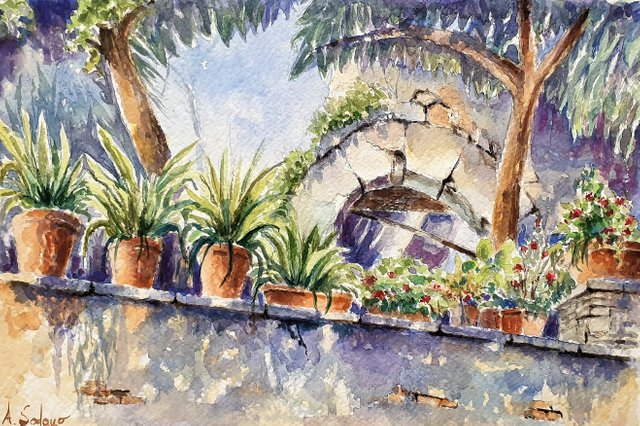
Another interesting trick for the landscape is to use the ochres and the lands of Siena or Bruciata, to give more elegant and natural shades.

Even brighter than usual shadows can be obtained with cerulean blue, in the case of a landscape with strong exposure to the sun, the same for the green of the leaves, a darker green or a little Prussian blue is enough.
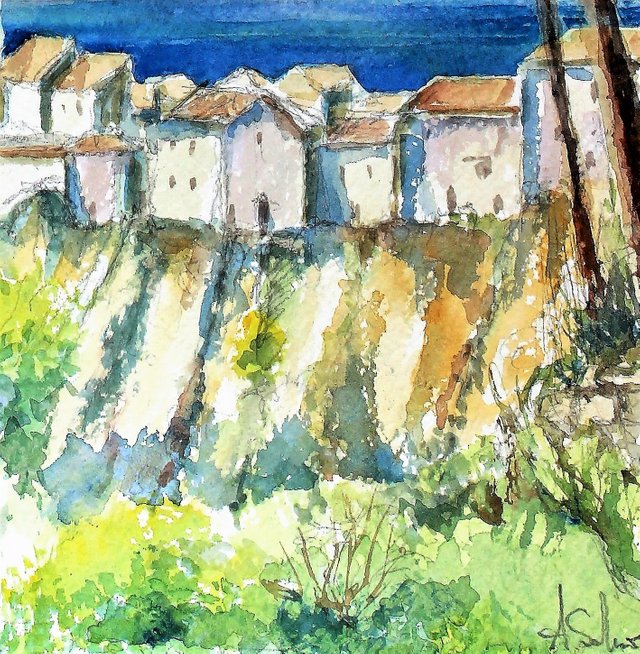


As for the waves of a rough sea, the discussion is more complicated, because you have to leave the white of the sheet of paper that represents the foam and the dark blue or gray paint the shadows.

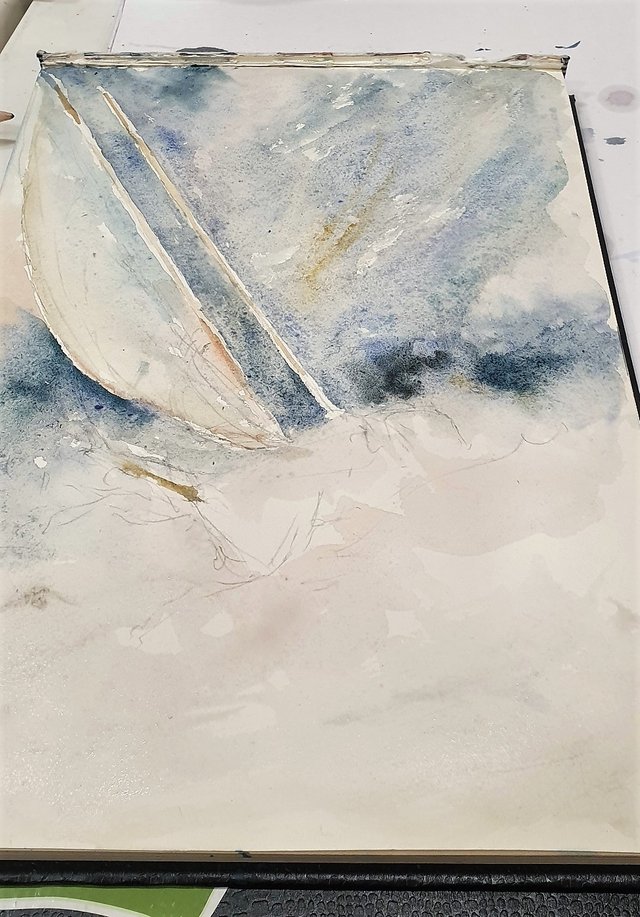
The beauty of a watercolor is precisely in its brightness and freshness of colors, I hope to have been clear.
Best wishes. Armando.
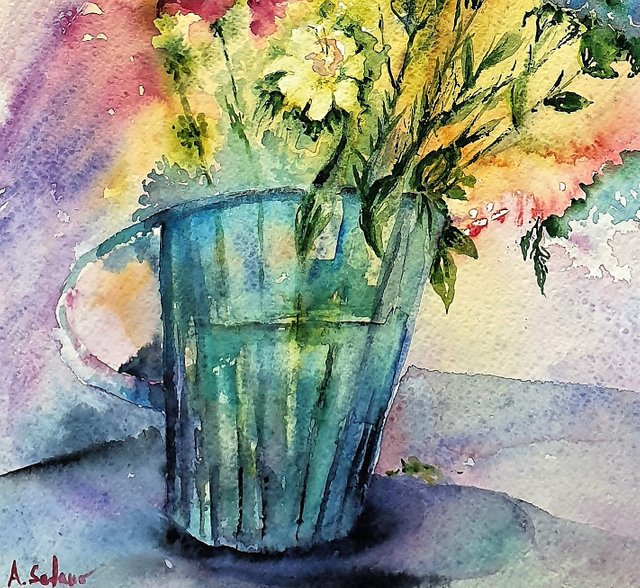
Come ottenere delle buone luci nella pittura ad acquarello.
Ciao a tutti cari amici e ben tornati sul mio blog.
Spero che stiate bene e al sicuro e che stiate trascorrendo una serena quarantena.
Oggi condivido con voi una serie di dipinti dove affronto il problema delle ombre nella pittura ad acquarello. Come molti di voi sanno il primo problema che abbiamo nella pittura ad acquarello è quello che lavoriamo in negativo, cioè dal chiaro allo scuro.
Quindi si stendono prima i colori chiari e poi per sovrapposizione i toni più scuri. Mentre nella pittura ad olio o ad acrilico possiamo aggiungere i bianchi per fare le luci alla fine del dipinto, con la tecnica pittorica ad acquarello questo non è possibile.
Non esiste il bianco ad acquarello!
Se poi vuoi realizzare un dipinto a tempera o gouche allora il bianco esiste, ma non è un acquarello ma è semplicemente una gouache o un dipinto a tempera.
La luce di un buon acquarello ci viene trasmessa dal colore bianco del foglio di carta, e più coloriamo sopra il foglio più l'acquarello rischia di perdere in luminosità.
I principianti tendono a riempire il disegno con molto colore, e sovrapponendoli l'uno sull'altro, rischiano spesso di avere un dipinto poco luminoso e brillante, con colori smorti e privi di vitalità.
Quindi oggi vi do dei suggerimenti con degli esempi visivi su alcuni miei acquarelli e come potete realizzare le ombre sugli elementi del paesaggio o della natura.
Il primo suggerimento importante e fondamentale per ottenere un buon dipinto luminoso è quello di non colorare le ombre con il nero, il colore nero si usa raramente!
Dimentica il nero!
Se ad esempio devo realizzare delle ombre su un paesaggio è meglio usare il violetto, e se lo mescolate con il blu cobalto è ancora più scuro ma conserva una buona luminosità.
Se voglio ottenere un ombra molto scura, sovrappongo il grigio di Payne al violetto.
Altro trucco interessante per il paesaggio è quello di usare le ocre e le terre di Siena o Bruciata, per dare ombreggiature più eleganti e naturali.
Ombre ancora più luminose del solito si possono ottenere con il blu ceruleo, in caso di un paesaggio con forte esposizione al sole, lo stesso per il verde delle foglie basta un verde più scuro o un po di blu di Prussia.
Per quanto riguarda le onde di di un mare agitato il discorso è più complicato, perchè bisogna lasciare il bianco del foglio di carta che rappresenta
la schiuma e con il blu scuro o il grigio si dipingono le ombre.
La bellezza di un acquarello è proprio nella sua luminosità e freschezza dei colori, mi auguro di essere stato chiaro.
Un caro saluto.
Armando.

my Facebook page: https://www.facebook.com/armando.sodano


Art teacher
Curator of cultural activities
Artistic director and President of the Cultural Association "I Colori della Vita"
https://www.icoloridellavita.life/
and "Fuori Controllo" Festival
https://www.facebook.com/fuoricontrollofestival/


Whooo amazing good to see you're still getting some of the steem here, my posts seems to be lowering their earnings each passing day....dunno if its because everyone is migrating to Hive or something else.
Downvoting a post can decrease pending rewards and make it less visible. Common reasons:
Submit
Watercolours look so nice. I just end up with messy blobs when I try to do anything with painting, especially water colours.
Downvoting a post can decrease pending rewards and make it less visible. Common reasons:
Submit
@tipu curate
Downvoting a post can decrease pending rewards and make it less visible. Common reasons:
Submit